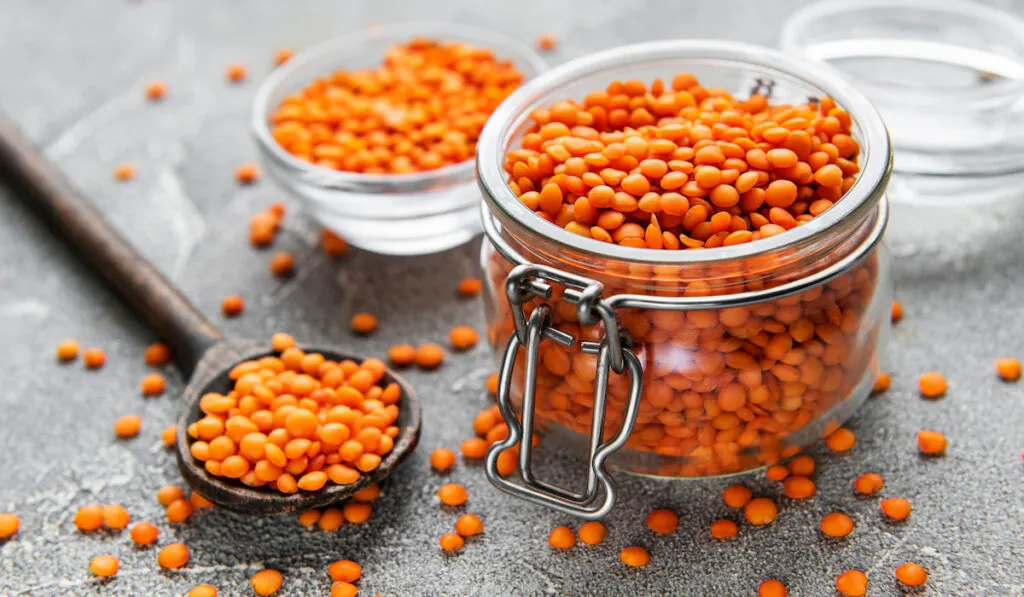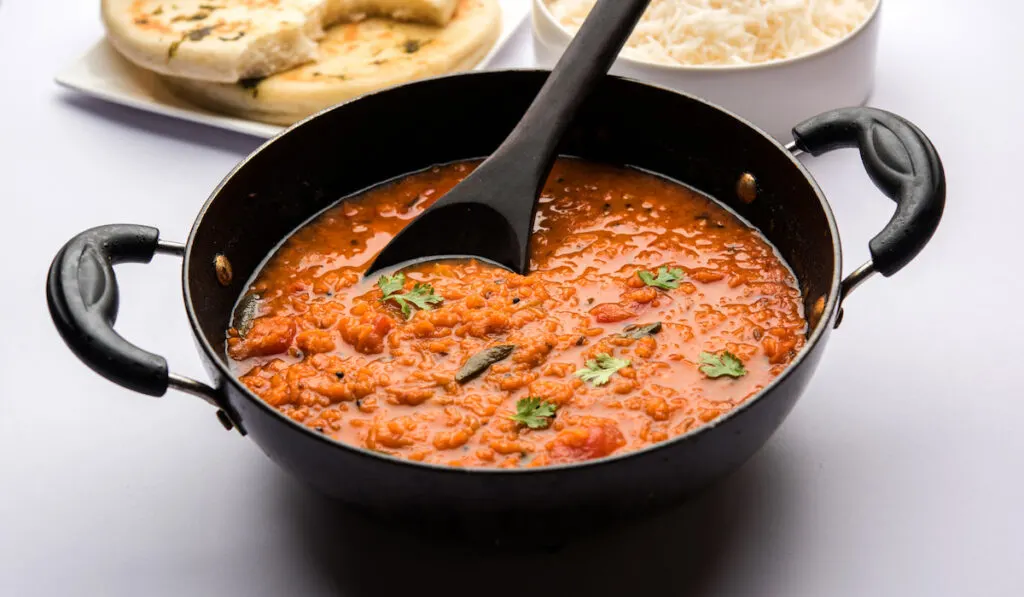Red lentils are the most misunderstood type of lentils because their coloring is found on the inside, making them harder to identify. This color brings them together with yellow lentils as a sweeter legume option, but there are three main types that you work with when cooking.
The 3 types of red lentils include:
- Corticated whole red lentils
- Decorticated whole red lentils
- Split red lentils
Each of these types has its own subsets and uses. Continue reading to learn what distinguishes red lentils from those of other colors, as well as their benefits and uses.
Table of Contents
Corticated Whole Red Lentils
Corticated whole red lentils are intact, meaning that they still have their skin. It can be harder to identify corticated whole red lentils as red because their skins usually do not look red, and they may be brown or even green on the outside.
Corticated whole red lentils are softer than those of other colors, and they cook much faster and have a softer consistency. You can cook whole red lentils without hulling them and still end up with a soft texture.
This variety of lentils is commonly used as a meat substitute, but you may also find it in pot pies and salads. If you need a lentil variety that will still retain its original shape and texture, then corticated whole red lentils may be your only option.
Decorticated Whole Red Lentils
Decorticated whole red lentils are made from the whole red lentil, but the skin is removed at this point. The process for removing the skins is called decortication, and it allows them to cook faster.
You may also see decorticated whole red lentils referred to as “footballs”. This is a reference to their lens shape that also closely resembles a football. These lentils are still whole, meaning that their two sides remain stuck together.
Because decorticated whole red lentils do not hold their shape as easily or as long, this type of red lentil is used more often in purees or soups.
Split Red Lentils
Split red lentils are decorticated and split, and they are the fastest cooking. Because they do not have their skin or as much area to heat up per lentil, the time is nearly cut in half from the whole lentil varieties.
Split red lentils are the variety most requested for dishes like:
- Lentille
- Masoor
- Mercimek
When you are cooking, keep in mind that a measurement of split red lentils will be slightly different than one of whole red lentils, both corticated and decorticated.
A dry cup of split red lentils can accommodate a greater number than whole varieties, and they do not weigh the same as corticated lentils.

What Do Red Lentils Taste Like?
Red lentils vary in taste from other color varieties. They are known to have a flavor described as:
- Mild
- Earthy
- Sweet
- Nutty
The sweetness is what most dishes are after when they call for red lentils instead of green or brown.
Keep in mind that if you are using a decorticated variety then the dish will lose the flavor of the skin. This usually means that it will have less of an earthy taste, and it may be sweeter.
Flavors that Work Well With Red Lentils
Despite the sweetness of red lentils, you will want to use herbs and spices to diversify the flavor. Instead of using only water when cooking red lentils, consider adding curry paste or coconut paste to improve the flavor.
To draw flavors from onion, garlic, or ginger, saute the ingredients in the pot before you add the red lentils and water to cook. This is the best way to get an authentic and fresh flavor, but you can use ground versions as needed.
When working with spices you can add them in before or after you cook the lentils, so try both ways to see which works better for you. Spices that pair with red lentils usually include:
- Garam Marsala
- Curry powder
- Turmeric
- Cumin
- Coriander
- Chili powder
You can also try adding herbs like cilantro, parsley, and dill after cooking.

The Health Benefits of Red Lentils
Not only are red lentils a palatable ingredient, but they provide plenty of health benefits.
Red lentils contain many nutrients known to improve heart health, including:
- Soluble fiber: keeps arteries clean
- Folate: lowers homocysteine levels
- Magnesium: improves the flow of blood, oxygen, and nutrients through the body
The insoluble fiber found in lentils is sufficient to prevent constipation. Those with advanced digestive disorders like irritable bowel syndrome and diverticulosis have expressed relief when adding red lentils to their diet.
The soluble fiber also helps slow down digestion by trapping carbohydrates. This leads to more stable blood sugar levels for anyone with insulin resistance, diabetes, or hypoglycemia.
Even without any medical conditions or concerns, red lentils are a great addition to your daily diet. They contain the third-highest level of protein of legumes and nuts, making them a great non-meat protein source.
Red lentils provide consistent energy over a longer period, and their iron levels help move oxygen through the body to produce energy and improve metabolic performance.
Their lower caloric and fat content lets you fill up on good nutrients without contributing to weight gain.

How to Cook Red Lentils
For the most part, you do not need to soak red lentils before cooking them. This is especially true with split red lentils that will lose their consistency in just a few minutes.
Make sure you sift through and rinse them beforehand, though. This removes any dirt or debris on the red lentils, and it gives you the opportunity to look for any rogue rocks that somehow made their way into your legumes.
When cooking red lentils you should opt for a ratio of 3 cups of water per 1 cup of lentils. The amount of time you spend boiling them changes depending on the variety, but it tends to be:
- 10+ minutes for corticated whole red lentils
- 7-10 minutes for decorticated whole red lentils
- 5-7 minutes for split red lentils
Try watching the pot the first few times you cook red lentils to gauge an appropriate time. The longer you cook them the softer they get.
Add salt after you boil the red lentils. Doing so beforehand will toughen them up.
Red lentils cook quickly and provide a sweet and savory boost to any dish you want to add them to, regardless of their type.
Resources
- https://www.kitchenskip.com/how-to-cook-red-lentils/
- https://onthegas.org/food/what-do-lentils-taste-like/
- https://cooking.stackexchange.com/questions/45357/are-red-lentils-and-split-red-lentils-the-same
- https://wearechefs.com/everything-you-ever-wanted-to-know-about-pulses/
- https://www.usapulses.org/technical-manual/chapter-2-general-properties/lentils
- https://jackrabbitbeans.com/products/red-lentils/
- http://www.nuragro.com/red-lentils.aspx
- https://www.cooksinfo.com/red-lentils
- https://cooking.stackexchange.com/questions/45357/are-red-lentils-and-split-red-lentils-the-same
